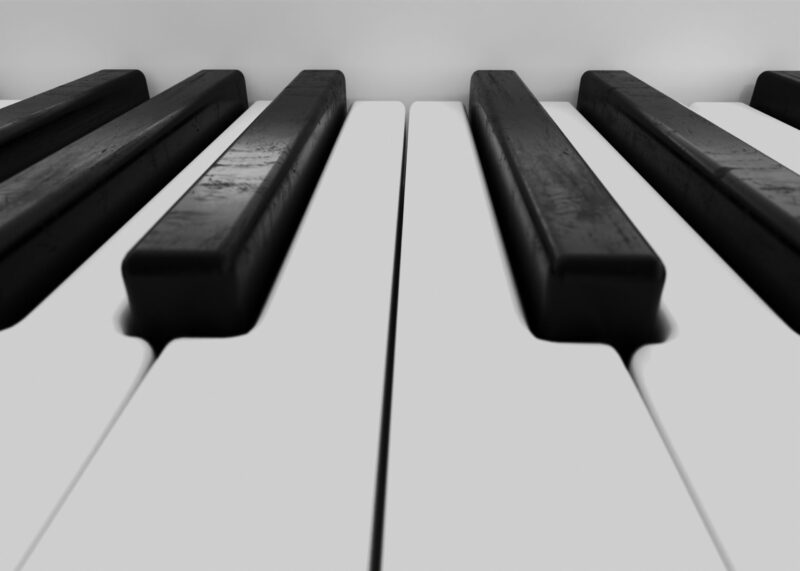Why Does Piano Start with C: Understanding the History of Musical Notation
When you first sit down at a piano, you may wonder why the keys are arranged the way they are. Specifically, why does the piano start with the note C? The answer lies in the history of music theory and the evolution of the modern keyboard.

In Western music theory, there are seven basic notes in a scale: A, B, C, D, E, F, and G. These notes repeat in higher or lower octaves, creating a total of 12 notes in a scale.
The modern keyboard is designed to reflect this pattern of notes, with white keys representing the seven basic notes and black keys representing the five sharps/flats that fall between them.
However, the keyboard was not always arranged this way. Early keyboard instruments like the harpsichord and clavichord had a different layout, with fewer keys and a different arrangement of notes.
It wasn’t until the 18th century that the modern keyboard layout became standardized, with C as the starting note. This decision was likely made for practical reasons, as C is a common note in many scales and is easy to recognize and remember.
Historical Context of Musical Notation

Evolution of Musical Scales
The history of musical scales dates back to ancient civilizations such as the Greeks, Egyptians, and Chinese. These civilizations developed their scales based on the natural harmonics produced by vibrating strings.
The Greeks, for example, used the monochord to study the ratios between different notes, which led to the development of the Pythagorean scale.
During the Middle Ages, the Guidonian hand was used to teach singers how to read and sing music. This system used hand gestures to represent different notes on a scale. The Guidonian hand was eventually replaced by the modern system of musical notation, which uses a staff with notes and symbols to represent different pitches and rhythms.
Influence of the Monochord
The monochord was a key instrument in the development of musical scales. It consisted of a single string stretched over a sound box, with moveable bridges to alter the length of the string and produce different notes.
The monochord was used by the Greeks to study the ratios between different notes, which led to the development of the Pythagorean scale.
The Pythagorean scale was based on the ratios of the first four harmonics produced by a vibrating string. This scale was later refined by the Greeks and used as the basis for Western music until the 16th century.
The monochord also played a role in the development of the Guidonian hand, which was used to teach singers how to read and sing music.
Music Theory Fundamentals

Chromatic Scale
The chromatic scale is a musical scale that consists of twelve pitches, each separated by a half step. The chromatic scale includes all the notes available in Western music, and it is the foundation of all scales and chords.
The chromatic scale starts on the note C, which is why the piano keyboard starts with the note C.
The chromatic scale is essential in music theory because it helps musicians understand how notes relate to each other.
By understanding the chromatic scale, you can learn how to build chords and scales, and how to transpose music into different keys.
Circle of Fifths
The circle of fifths is a visual representation of the relationships between the 12 notes of the chromatic scale. It is a tool that helps musicians understand the relationships between different keys and how to modulate between them.
The circle of fifths is based on the intervals of a perfect fifth, which is the distance between two notes that are seven half-steps apart.
The circle of fifths starts with the note C, and it moves clockwise in a series of perfect fifths.
The circle of fifths is a useful tool for musicians because it helps them understand the relationships between different keys and how to modulate between them.
By understanding the circle of fifths, you can learn how to build chords and scales in different keys, and how to navigate complex chord progressions.
Piano Keyboard Layout

When you look at a piano keyboard, you might notice that it starts with the note C. This is not a coincidence, but rather a deliberate choice made by the instrument’s designers. In this section, we will explore why the piano keyboard layout begins with C.
C as Reference Point
The choice to start the piano keyboard with the note C was made for practical reasons. C is a convenient reference point because it is a white key located to the left of a group of two black keys and to the right of three black keys.
This pattern repeats throughout the keyboard, making locating and identifying other notes easy.
In addition, C is also the note that corresponds to the first letter of the musical alphabet. This makes it a logical starting point for beginners who are learning to read sheet music and understand musical notation.
Visual Symmetry
Another reason why the piano keyboard layout starts with C is related to visual symmetry.
The designers of the piano wanted to create a visually balanced instrument that would be aesthetically pleasing to look at.
By starting with C, they were able to create a pattern of alternating black and white keys that is both visually appealing and easy to navigate.
Furthermore, the layout of the piano keyboard is based on the diatonic scale, which consists of seven notes. Starting with C allows for a symmetrical arrangement of these notes, with three white keys to the left of C and four white keys to the right.
Pedagogical Reasons
Learning and Teaching Approach
One of the main reasons why the piano starts with C is due to pedagogical reasons. The C major scale is the simplest scale to learn and understand, making it an ideal starting point for beginners.
By starting with C, students can learn the basics of music theory and keyboard layout, such as the placement of notes on the staff and the corresponding keys on the piano.
The learning and teaching approach for piano typically starts with the C major scale, the G major scale, and then the D major scale. This approach allows students to gradually build their knowledge and skills, starting with the simplest keys and scales and progressing to more complex ones.
Starting with C allows for easy transposition to other keys. Since the C major scale contains no sharps or flats, it is easy to transpose to other keys by simply moving up or down the keyboard.
This makes it easier for students to understand the relationship between different keys and scales and to apply their knowledge to new pieces of music.
Cultural and Practical Influences
When it comes to the naming of notes on a piano, cultural and practical influences play a significant role. The modern piano keyboard is based on the diatonic scale, which consists of seven notes. The first note of the diatonic scale is C, which is why the piano keyboard starts with C.
One cultural influence on the naming of notes is the use of solfeggio syllables in Western music education. The solfeggio syllables are a system of syllables that represent each note of the diatonic scale. The syllables are: Do, Re, Mi, Fa, Sol, La, and Ti.
In this system, C is represented by the syllable “Do,” which further reinforces its importance as the first note of the scale.
Another practical influence on the naming of notes is the placement of the black keys on the piano keyboard.
The black keys are arranged in groups of two and three, which creates a repeating pattern throughout the keyboard. This pattern makes it easier to identify and play the notes, especially for beginners. Starting with C allows for this pattern to be maintained throughout the keyboard.
Frequently Asked Questions
Why is the C note considered the starting point for scales on the piano?
The C note is considered the starting point for scales on the piano because it is the note that is easiest to identify and locate. It is also the most basic note in the Western music system, and it is the note from which all other notes are derived. The C note is also the note that is most commonly used in the construction of chords and harmonies.
What historical reasons led to C being the first note of the piano scale?
The historical reasons for C being the first note of the piano scale are not entirely clear. However, it is believed that the use of the letter C to denote the first note of the scale may have originated from the use of the letter A to denote the first note of the alphabet. The letter C was then used to denote the first note of the scale because it was the next letter in the alphabet after A and B.
How did the convention of C major as the default piano tuning come about?
The convention of C major as the default piano tuning came about because it is the most natural and easiest key to tune. The C major scale contains no sharps or flats, which means that all of the notes in the scale are natural notes. This makes it easier to tune the piano and ensures that the notes are in tune with each other.
In music theory, why is the C note the reference point for major scales?
In music theory, the C note is the reference point for major scales because it is the most basic note in the Western music system. The C major scale contains no sharps or flats, which makes it the most natural and easiest key to understand. It is also the key that is most commonly used in the construction of chords and harmonies.
Why do octaves on the piano traditionally begin with the note C?
Octaves on the piano traditionally begin with the note C because it is the note that is easiest to identify and locate. It is also the most basic note in the Western music system, and it is the note from which all other notes are derived. The C note is also the note that is most commonly used in the construction of chords and harmonies.
What is the rationale behind the arrangement of piano keys starting with C?
The arrangement of piano keys starting with C is based on the natural order of the notes in the Western music system.
The white keys on the piano correspond to the natural notes of the C major scale, and the black keys correspond to the sharps and flats of the scale.
The arrangement of the keys ensures that the notes are in the correct order and that the piano is easy to play and understand.






